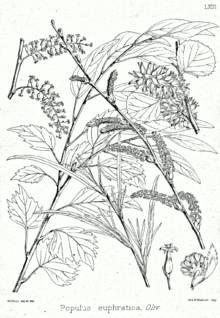Populus euphratica
| Populus euphratica | |
|---|---|
 | |
| Leaves, flowers and fruits, illustration from Forest Flora of North-West and Central India, published 1874 by Kurt Stüber | |
| Scientific classification | |
| Kingdom: | Plantae |
| (unranked): | Angiosperms |
| (unranked): | Eudicots |
| (unranked): | Rosids |
| Order: | Malpighiales |
| Family: | Salicaceae |
| Genus: | Populus |
| Species: | P. euphratica |
| Binomial name | |
| Populus euphratica | |
| Synonyms[1] | |
| |
Populus euphratica, commonly known as the Euphrates poplar[2] or desert poplar, is a species of poplar tree in the willow family.
Description
The Euphrates poplar is a medium-sized deciduous tree that may grow to a height of about 15 m and a girth of 2.5 m (8.2 ft) where conditions are favourable. The stem is typically bent and forked; old stems have thick, rough, olive-green bark. While the sapwood is white, the heartwood is red, darkening to almost black at the centre. The roots spread widely but not deeply. The leaves are highly variable in shape. The flowers are borne as catkins, those of the male are 25–50 mm (0.98–1.97 in) long, those of the female 50–70 mm (2.0–2.8 in). The fruits are ovoid-lanceolate capsules, 7–12 mm (0.28–0.47 in) long, containing tiny seeds enveloped in silky hairs.[3]
Distribution and habitat
The species has a very wide range, occurring naturally from North Africa, across the Middle East and Central Asia to western China. It may be found in dry temperate broadleaf and mixed forests and subtropical dry broadleaf forests at altitudes of up to 4,000 m (2.5 mi) above sea level. It is a prominent component of tugay floodplain ecosystems along river valleys in arid and semi-arid regions, mixed with willow, tamarisk and mulberry in dense thickets. It grows well on land that is seasonally flooded and is tolerant of saline and brackish water. Much used as a source of firewood, its forests have largely disappeared or become fragmented over much of its natural range.[3][4]
Uses
The species is used in agroforestry to provide leaves as fodder for livestock, timber and, potentially, fibre for making paper. It is also used in afforestation programs on saline soils in desert regions, and to create windbreaks and check erosion. The bark is reported to have antihelminthic properties.[3]
References
- ↑ The Plant List: A Working List of All Plant Species, retrieved 26 September 2016
- ↑ Heptner, V. G.; Sludskij, A. A. (1992) [1972]. Mlekopitajuščie Sovetskogo Soiuza. Moskva: Vysšaia Škola [Mammals of the Soviet Union. Volume II, Part 2. Carnivora (Hyaenas and Cats)]. Washington DC: Smithsonian Institution and the National Science Foundation. pp. 1–732.
- 1 2 3 "Populus euphratica". Agroforestry Tree Database. World Agroforestry Centre. Retrieved 2013-04-16.
- ↑ Treshkin, S.Y., S.K. Kamalov, A. Bachiev, N. Mamutov, A.I. Gladishev and I. Aimbetov. 1998. Present status of the tugai forests in the lower Amu-Dar’ya Basin and problems of their protection and restoration. Pages 43-53 in Ecological Research and Monitoring of the Aral Sea Deltas. A Basis for Restoration. UNESCO Aral Sea Project, 1992-1996 Final Scientific Reports, UNESCO, Paris, France.
![]()
![]()